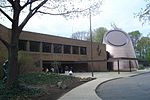Montessori High School at University Circle
Montessori High School at University Circle (also known as MHS) was a private high school located in the University Circle neighborhood of Cleveland, Ohio. The school opened August 2008 as the first private high school in the United States with the Montessori name, and was the first Montessori high school to offer boarding for international and U.S. students. On May 4, 2018, MHS announced that it would cease operations and liquidate its properties at the end of the 2017-18 academic year due to financial difficulties. MHS combined Montessori education with the International Baccalaureate program, a demanding college-preparatory program stressing the classical liberal arts. MHS was one of five high schools in the United States to combine these educational approaches.
Excerpt from the Wikipedia article Montessori High School at University Circle (License: CC BY-SA 3.0, Authors).Montessori High School at University Circle
Magnolia Drive, Cleveland
Geographical coordinates (GPS) Address External links Nearby Places Show on map
Geographical coordinates (GPS)
| Latitude | Longitude |
|---|---|
| N 41.514944444444 ° | E -81.609722222222 ° |
Address
Mastery School of Hawken
Magnolia Drive 10923
44106 Cleveland
Ohio, United States
Open on Google Maps




